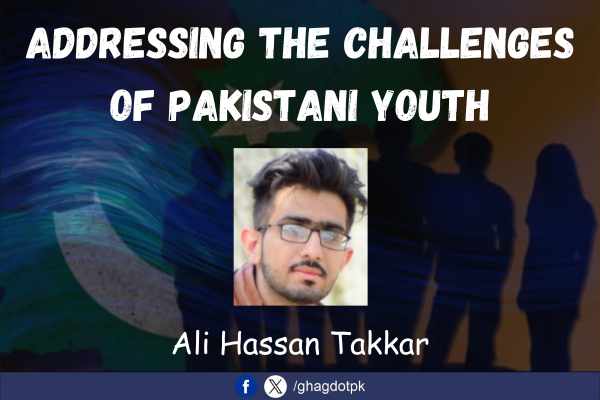By Ali Hassan Takkar
Youth are the building blocks of any nation. In a country like Pakistan, where nearly 70% of the population falls within the youth demographic, their potential to contribute to national development is immense.
However, this potential is being restrained by a range of challenges that prevent the youth from achieving their full capabilities. From lack of access to quality education to mental health crises, these issues need urgent attention and a multifaceted approach, demanding comprehensive solutions to progress and develop in the era of technology and advancement.
The education system in Pakistan is one of the key areas holding back the country’s youth. Despite a large number of young people seeking education, access to quality learning remains limited. Many schools lack basic facilities, the curriculum is outdated, and there is little to no focus on skills that align with the demands of a modern economy besides the lack of skills enhanced is another barrier in pursuing an academic journey.
A system focused largely on rote memorization, devoid of practical life skills, has left young people unprepared for the challenges of a rapidly evolving world. The enhancement of innovation, critical thinking, and creativity is often sidelined in favor of traditional learning methods, which stifle potential. As a result, many young people leave educational institutions without a clear direction or the tools necessary for survival in this era.
What Pakistan needs is an overhaul of the education system, one that prioritizes quality over quantity. Institutions should be equipped with modern teaching methods, and the curriculum must integrate life skills, creativity, and vocational training.
Education should not just be about passing exams, but about preparing young people for real-life hurdles and on-field realities. The curriculum should focus more on the grassroots problem and its solutions instead of old-school theorists and memorization.
And even those who manage to overcome the barriers within the education system face another daunting challenge: unemployment. Pakistan’s job market has not kept pace with the number of educated young people entering the workforce. The result is frustrating, with many young graduates unable to find meaningful work that matches their qualifications.
The government and private sector must collaborate to create job opportunities for young people. Expanding internship programs, offering skill-based training, and fostering entrepreneurship are critical measures. If young people are not provided the means to build their futures, the nation’s progress will stall.
A lack of vocational guidance is another key issue plaguing Pakistan’s youth. Many young people are uncertain about their career paths due to inadequate professional counseling and mentorship opportunities. Educational institutions rarely provide career counseling, and there is no systematic approach to help students identify and nurture their interests or talents.
Implementing a structured vocational guidance system in schools and universities would go a long way toward addressing this issue.
Counseling services that help students explore various career options, understand their strengths, and develop a clear path forward would prevent the drift many young people experience after graduation.
The mental health of Pakistan’s youth is another issue that deserves urgent attention. Depression, anxiety, and stress are rampant, often fueled by societal pressures, unemployment, and the uncertainty of the future. Unfortunately, mental health issues remain taboo in much of Pakistani society, and young people often suffer in silence.
Raising awareness about mental health and making resources accessible is essential. Schools and universities should provide mental health counseling, and national campaigns should work to destigmatize mental health care. Only when youth can express their struggles openly will they be able to overcome them?
Parents and elders must strike a balance between guiding the youth and allowing them the freedom to explore their aspirations. Open dialogue between generations is crucial for fostering mutual understanding and ensuring that young people can contribute to the nation’s development in meaningful ways.
The rapid advancement of technology has left rural youth behind, as access to the internet and modern devices remains scarce in many parts of Pakistan. This digital divide further exacerbates the gap between urban and rural populations, limiting opportunities for education and employment in rural areas.
Bridging this divide should be a priority for the government. Ensuring that internet access is available in rural areas would not only help level the playing field but also open up new avenues for learning and economic participation for rural youth.
One of the darker challenges facing Pakistan’s youth is their susceptibility to extremism. With limited opportunities for education and employment, some young people fall prey to extremist ideologies that promise a sense of purpose and belonging.
To combat this, the government and civil society must work to promote positive activities and offer alternatives through education and vocational training. Youth engagement in constructive activities, such as sports, arts, and technology, can divert them from paths of extremism and help build a more inclusive society.
Drug addiction among youth is a serious and growing concern in Pakistan. According to the United Nations Office on Drugs and Crime (UNODC), over 6.7 million Pakistanis between the ages of 15 and 64 are drug users, with young people being the most affected group. Educational institutions in major cities like Karachi, Lahore, and Islamabad are seeing rising drug abuse, a trend that threatens not only the health but also the prospects of the youth.
Addressing this issue requires a multi-faceted approach, including public awareness campaigns, stronger law enforcement against drug trafficking, and accessible rehabilitation services. This issue deserves particular focus to ensure a safer, healthier future for Pakistan’s young population.
Pakistan’s youth are the most valuable asset, but the challenges they face are significant. Addressing these issues requires a coordinated effort from the government, private sector, and civil society. By increasing investment in education, creating economic opportunities, addressing mental health, reducing social pressures, and fostering political participation, Pakistan can unlock the full potential of its youth.
Only by listening to the voices of the younger generation and offering them the tools to succeed can Pakistan hope to build a prosperous future.






